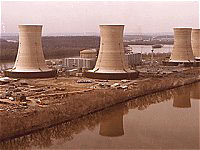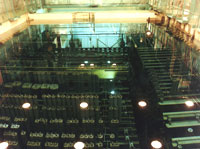Over the last 15 years, the nuclear power industry has lobbied the Nuclear Regulatory Commission and Congress to weaken security requirements at atomic plants, even as the threat of terrorism has grown. But in reality, as Shelley Smithson shows in Part I of this series, nuclear energy security is already poor. In drills conducted by the NRC over the last decade, guards at nearly half the country’s nuclear plants failed to stop mock terrorists from simulating serious damage, and atomic facilities are not required to protect themselves from large truck bombs or aerial attacks. In Part II of this series, below, Smithson looks at how the industry and its regulator are trying to derail legislation that would make plants less vulnerable to attack.
Despite the mounting concern about nuclear power plant security after Sept. 11, the Nuclear Regulatory Commission hasn’t shown much inclination to toughen safety standards. Instead, the NRC is considering replacing its own inspection program with an initiative, favored by the nuclear industry, that would allow utilities to design, administer and grade their own security tests, with far less NRC input.
For more than three years, the Nuclear Energy Institute, the lobbying arm of the atomic power industry, has been pressuring the NRC to scrap its security inspections, because preparing for the drills and correcting problems is costly. In 1998, NRC managers acquiesced and killed the security evaluation program, but it was quickly reinstated on orders from the Clinton administration. A month later, NRC managers submitted a plan for a pilot project that would allow plant managers to evaluate their own security forces. Depending on the commission’s satisfaction with the one-year pilot program — which was supposed to begin last fall — the industry drills could eventually replace the NRC-administered program. “We’re not saying the NRC shouldn’t have oversight,” said Doug Walters, a senior licensing manager at the NEI. “The oversight should be on how well we assess ourselves.”
But Capt. David Orrik, a former Navy Seal who now heads the NRC’s security inspection program, said there is no way to guarantee utilities will not teach to the test. “When we go in, they don’t know where the adversary will attack from, what target sets they’re going for, what tactics they’re going to use,” he said. Under the industry plan, NRC security specialists will observe a test that has been planned and executed by the utility. “The way it’s set up, I have severe misgivings about our ability to determine how effective it is,” Orrik said.

NRC Chair Richard Meserve.
Photo: NRC.
After Sept. 11, NRC Chair Richard Meserve said the agency would reconsider whether it is appropriate to allow utilities to write and grade their own security tests. But an internal memo sent to NRC staff by management on Oct. 19 indicates that the industry-backed pilot program will go forward as planned as soon as security drills are reinstated.
The Nuclear Security Act of 2001, introduced by Democratic legislators in the Senate and House, would require the NRC, not the industry, to evaluate plant security. In addition, the legislation calls for tests every other year instead of every eight years, and utilities that failed the drill would be tested again every six months until they passed. The legislation would also give the NRC 18 months to write new rules about where guards, gates, and other vehicle barriers must be located at each of the nation’s atomic plants, “taking into account the events of Sept. 11.”
The Surly Gates
In a letter sent to President Bush on Dec. 7, the president of the Nuclear Energy Institute argued that America’s atomic power plants are “surrounded by perimeter defenses that rival those of military installations.” He did not mention that two hours after planes crashed into the World Trade Center and the Pentagon, guards at the Three Mile Island plant in Pennsylvania were still struggling to close a gate that is supposed to stop terrorists from entering. Nor did he note that there were no guards or gates at most plant entrances across the country before Sept. 11. Since then, at least a dozen states have asked the National Guard to stand watch outside nuclear plants to check IDs and search incoming vehicles for weapons and explosives.

Three Mile Island in 1979.
Photo: U.S. EPA.
But after the National Guard leaves, many residents worry that plant entrances will again be vulnerable. “My concern is if a truck carrying a bomb gets on Three Mile Island, it can do a lot of damage,” said Scott Portzline, an activist with Three Miles Island Alert who lives in Harrisburg, Pa., 10 miles from the plant. “It can go through an unescorted entrance and get to some specific, vital places within 30 seconds.”
On Sept. 12, Three Mile Island Alert filed a petition asking the NRC to require armed guards at plant entrances to act as a physical and visual deterrent to would-be terrorists. “Without an NRC requirement, many licensees will not volunteer this protection because of generic cost-cutting measures taken over the past few years to remain competitive in a deregulated utility market,” Portzline wrote in the petition. “Three Mile Island’s entrance is less protected now than at any time in history.”
Adding guards at the front doors of plants would be “a relatively inexpensive protection,” the petition said. Adding reinforced gates at the entrances of all the plants in the country would be far more costly, but something that watchdog organizations say is necessary.
Who Makes the Rules?
What about security measures beyond the front gates? After years of denying petitions by citizens groups, the NRC finally issued rules in 1994 that require utilities to install vehicle barriers around buildings that contain vital safety equipment. Heavy hydraulic gates, “nuclear grade” lifting gates, and fences reinforced with concrete and chain posts keep unauthorized vehicles away from protected areas. The NRC reluctantly imposed these rules after a former mental patient crashed his station wagon into the turbine building at Three Mile Island in 1993. Nineteen days later, a rental van packed with ammonium nitrate and diesel fuel exploded in the underground parking garage of the World Trade Center, killing six people. Four days after that, the New York Times received a letter warning that 150 suicidal soldiers “will continue to execute our missions against military and civilian targets” in the United States, including “some potential nuclear targets.”
At an NRC meeting held later that spring, NRC commissioners discussed whether the rules should be changed to require gates and fences around vital equipment. Citing the high costs involved, Ivan Selin, then chair of the commission, said plants should be asked to “do what they can reasonably do, without going to a rule.” Commissioner James Curtiss, who later became a lobbyist for the nuclear industry, objected to any new rules, saying if the NRC required protection against truck bombs, “people will come forward and seek protection against air bombs”
Ultimately the NRC adopted a rule requiring plants to install gates and fences that would keep out a 4×4 truck loaded with explosives. But after the Oklahoma City bombing in 1995, citizen groups asked the NRC if the barriers were far enough from vital equipment to prevent damage from a large truck bomb. “We kept asking, would your truck bomb rule protect against a bomb Oklahoma City-size?” said Daniel Hirsch, president of Committee to Bridge the Gap, a Los Angeles nuclear watchdog group. “The answer was pretty clearly no.”

Spent nuclear fuel pool.
Photo: DOE.
The NRC has also rejected requests by citizens groups that want utilities to reinforce buildings containing radioactive waste. Used nuclear fuel rods that were supposed to be shipped to a permanent repository by 1998 remain in pools of borated water at nuclear plants across the country. Prefabricated, industrial buildings are all that shelter the fuel pools, which are located either slightly below ground or in structures as tall as seven stories.
In a 1995 petition, the Washington, D.C.-based National Whistleblower Center argued that an airplane or missile could easily penetrate a spent fuel building and potentially crack the concrete wall or floor of the pool. Without water to cool it, radioactive fuel would overheat and either melt or catch fire, endangering the lives of thousands of people within a 50-mile radius, according to an NRC study. Nonetheless, the agency denied the petition, saying it could not require reinforcement of spent fuel buildings since it does not mandate that reactors or other equipment buildings be protected against aerial attack.
The legislation introduced in the House and Senate would give the NRC three months to write new rules to better protect plants against an aerial attack on reactors, equipment buildings, and spent fuel pools. This could mean imposing a permanent no-fly zone around nuclear plants or requiring utilities to fortify protective buildings. Some groups have called for the military to install weapons atop reactors that could shoot down incoming planes.
But nuclear utilities say they should not be required to protect against enemies of the state, nor should they have to pay for measures they believe are excessive. The Nuclear Security Act would require plants to pay for federal guards, increased NRC security testing, and more physical barriers. “I don’t think this is economic-driven opposition,” Mitch Singer of the Nuclear Energy Institute said. “It is the industry’s position that the way the system is set up now is pretty good.”
Industry critics say utility lobbyists are following the same pattern they have for years — denying the existence of a problem while delaying the rulemaking process to save money on security. It’s the same approach the airline industry used to stall tougher security measures on airplanes and in airports, said Edwin Lyman, scientific director of the D.C.-based Nuclear Control Institute, an anti-nuclear group. “It’s exactly the same at nuclear plants,” he said. “The industry is involved heavily in trying to shape things the way they want them. Things slow to a crawl, and meanwhile, the vulnerability is still there.”
Back to Part One: How secure are U.S. nuclear power plants?

